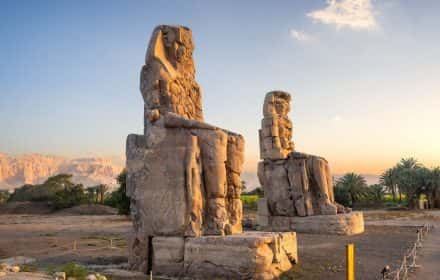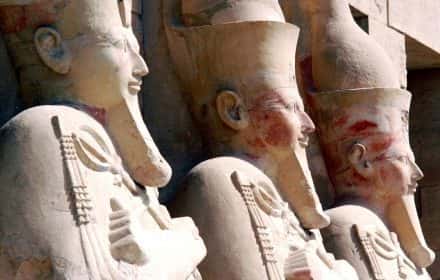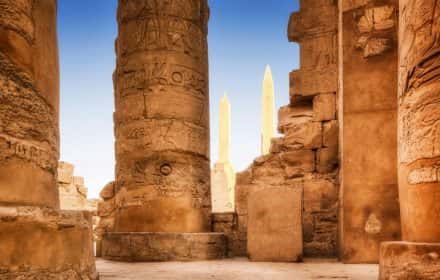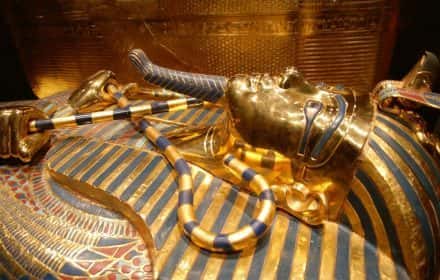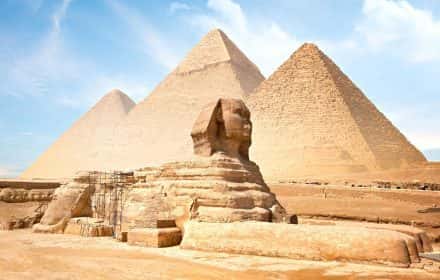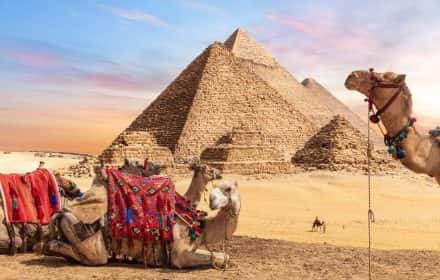This site uses affiliate links, meaning that if you make a purchase through our links, we may earn an affiliate commission.
Nestled amidst the timeless sands of Luxor, the Temple of Hatshepsut stands as a breathtaking testament to ancient Egyptian grandeur.
As you step onto the sacred grounds of this archaeological marvel, you embark on a journey through time, retracing the footsteps of a remarkable queen whose legacy endures in the form of a temple that has withstood the test of millennia.
This awe-inspiring structure, hewn into the rugged cliffs of Deir el-Bahri, bears witness to the profound influence of Queen Hatshepsut, one of ancient Egypt’s most enigmatic and powerful monarchs. Her reign, spanning over two decades during the 15th century BCE, was characterized by remarkable accomplishments, and the temple dedicated to her memory reflects her enduring impact on history.
In this curated exploration, we invite you to uncover the hidden wonders that lie within the Temple of Hatshepsut. 7 astonishing things to see at the Temple of Hatshepsut promises a journey filled with intrigue, mystique and a deep sense of connection to a bygone era. From colossal statues guarding the entrance to the intricate hieroglyphics that line its walls, every facet of this temple beckons with the allure of a time when Egypt reigned supreme.
So, prepare to embark on this extraordinary journey of discovery, where you will be transported to a world where the echoes of history whisper their secrets, and the marvels of ancient Egypt await your gaze.
Let us unveil the majesty of the Temple of Hatshepsut, where the sands of time have preserved a legacy that continues to inspire awe and wonder in the modern era.
The Temple of Hatshepsut
- 1. Who Was Hatshepsut
- 2. What to See at the Temple of Hatshepsut - 7 Things You Can't Miss
-
- 2.1. The Courtyard
- 2.2. The Southern Colonnade
- 2.3. Second Level of the Temple
- 2.4. Chapel of Hathor
- 2.5. The Punt Colonnade
- 2.6. The Anubis Chapel
- 2.7. The Sanctuary of Amun
- 3. Intrepid Scout's Tips for Visiting the Temple of Hatshepsut
Who Was Hatshepsut
To start off, before you head to the Temple of Hatshepsut, you need to find out who Hatshepsut was:
- Hatshepsut (born c. 1507 BC – died 1458 BC) was the daughter of Thutmose I. She became the queen of Egypt when she married her half-brother Thutmose II.
Upon the death of Thutmose II, Hatshepsut began acting as regent for her stepson Thutmose III.
- Hatshepsut was supposed to control the affairs of the state until Thutmose III was to come of age. However, around 1473 BC, Hatshepsut broke with the tradition and had herself crowned as the pharaoh of Egypt becoming a co-ruler of Egypt with Thutmose III.
- Hatshepsut ruled for almost 20 years. She died about 1458 BC. How and why she died is still a mystery. What we know, is that Thutmose III had her name and image almost completely erased. She remained forgotten for centuries.
- It was not until 1829 AD, when the hieroglyphs on the walls of the Mortuary Temple of Hatshepsut were decoded, that we were able to learn about her existence.
- Hatshepsut’s major accomplishment was opening and expanding the trade routes. Her expedition to the Land of Punt is beautifully documented in the section of the Temple of Hatshepsut called the Punt Colonnade.
- Besides trade, Hatshepsut oversaw an immense period of building across Egypt. Needless to say, she was probably one of the most prolific builders in Egyptian history.
What to See at the Temple of Hatshepsut - 7 Things You Can't Miss
The Courtyard
The Ground Level of the Temple of Hatshepsut has a large Courtyard. As you pass through it, imagine how magnificent it must have been with exotic trees brought from the expedition to the land of Punt and planted here.
Also, imagine how stunning the Courtyard must have looked with the avenue of the sphinxes. Now, they are gradually being restored.
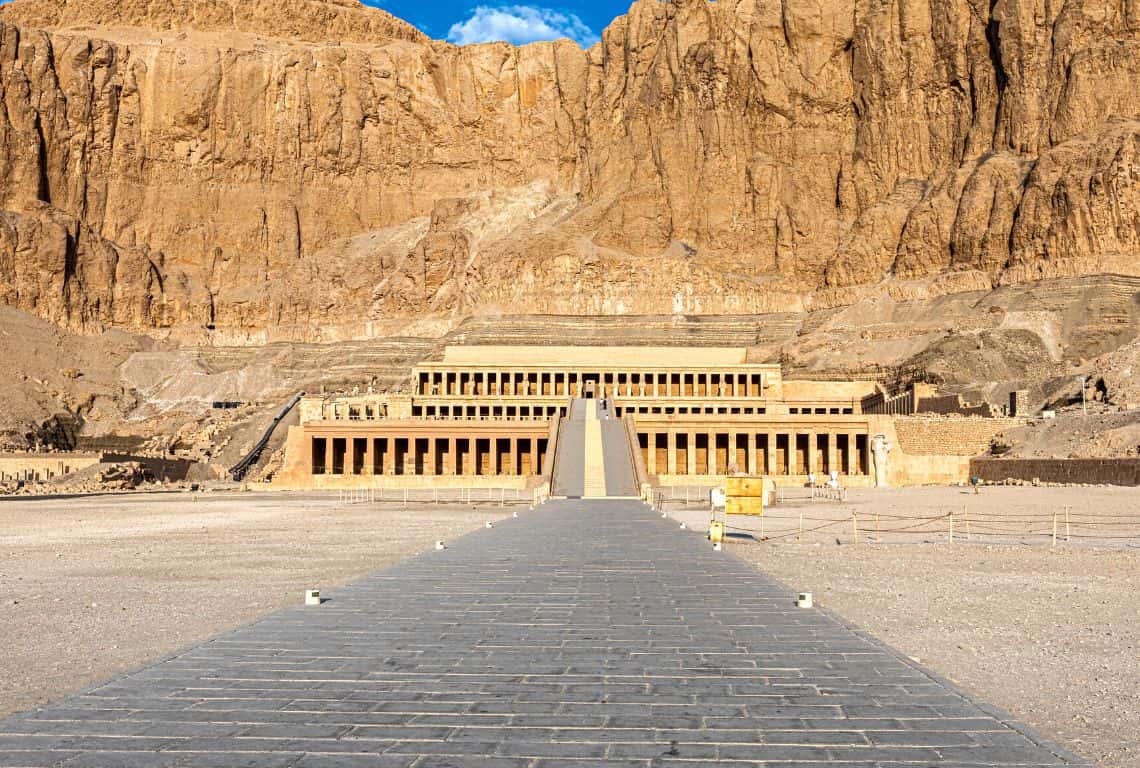
The Courtyard at the Temple of Hatshepsut / Things to See at the Temple of Hatshepsut
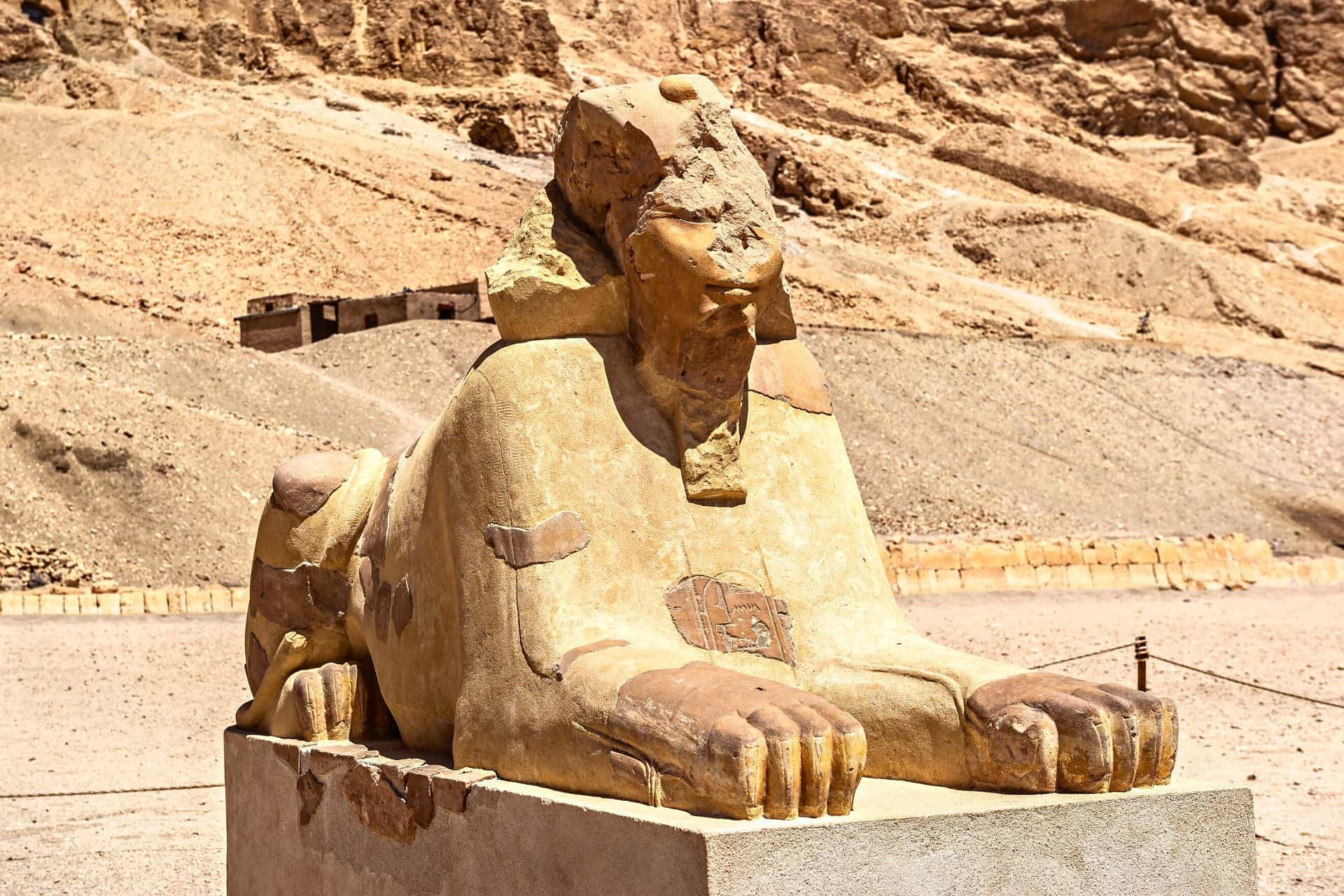
The Avenue of the Sphinxes / Things to See at the Temple of Hatshepsut
The Southern Colonnade
Next, take your time and meander through the two colonnades that have already been restored. They comprise of spectacular 22 columns on each side arranged in double rows.
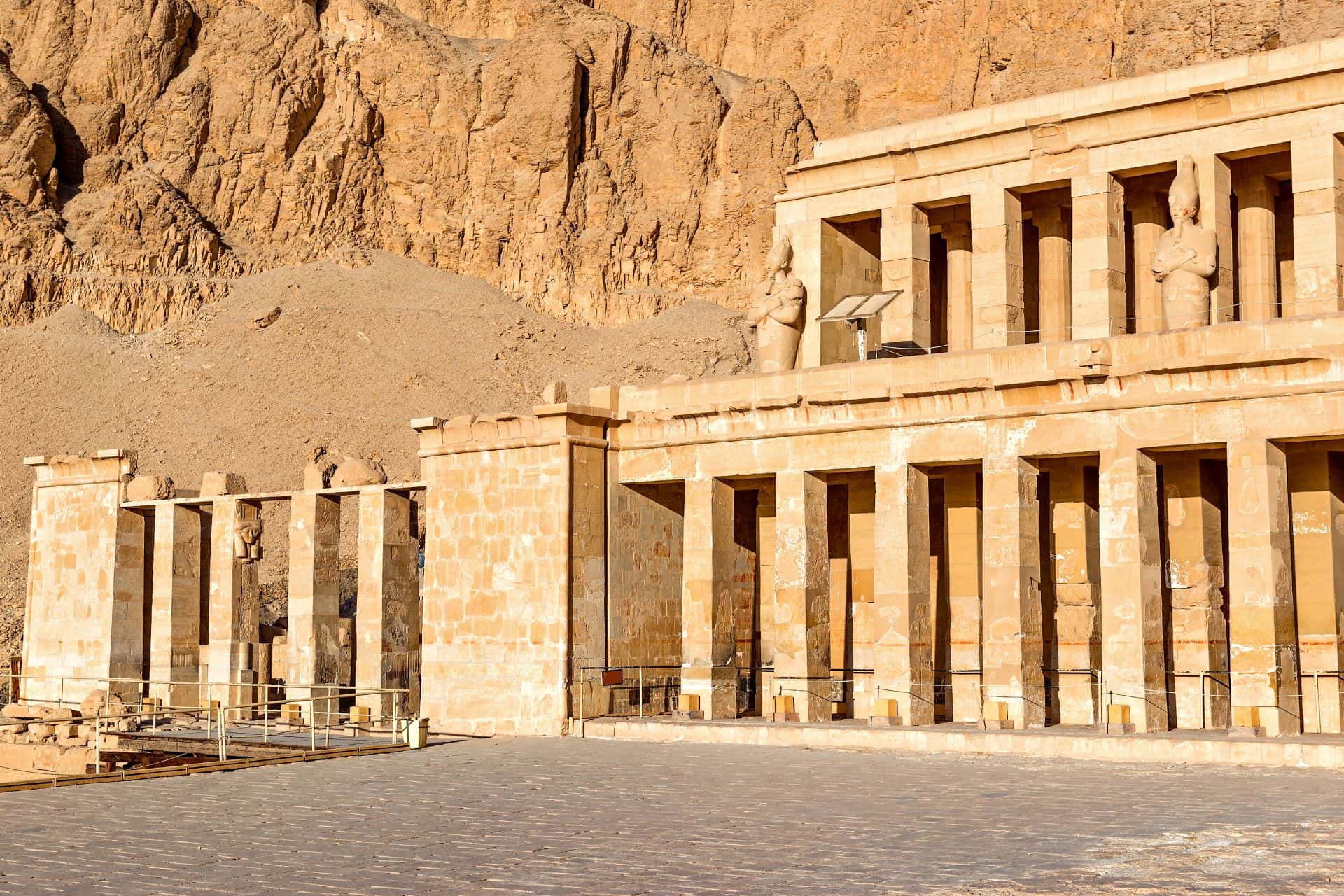
The Southern Colonnade / Things to See at the Temple of Hatshepsut
Make your way to the Southern Colonnade. It is located on the left-hand side of the courtyard.
Here, you will find the scene showing two obelisks being transported by water. These are the two obelisks that Hatshepsut had erected at the Karnak Temple.
If you look closely at the relief, you can see that the first two rows show the obelisks on the decks of the large barges. Right below, you can see a parade of the troops as a part of the festivities which were held to celebrate the arrival of the obelisks at the Karnak Temple.
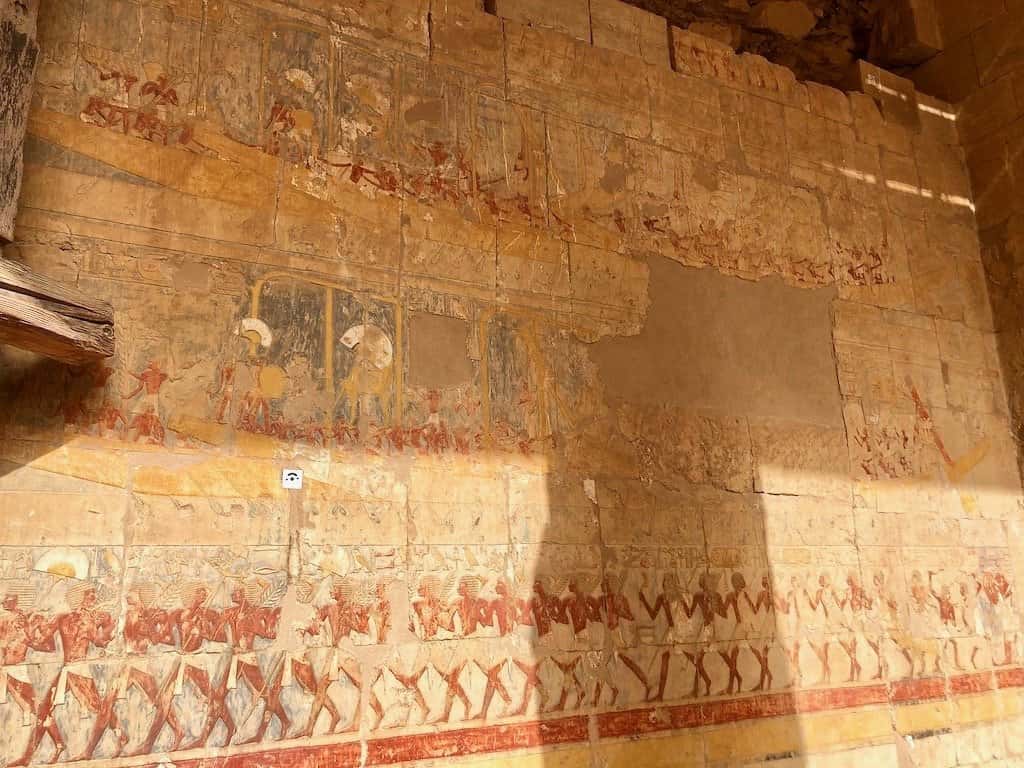
The Southern Colonnade / Things to See at the Temple of Hatshepsut
The transportation and erection of obelisks in ancient Egypt were remarkable engineering feats, often associated with religious and ceremonial significance.
The transportation of these colossal obelisks to Karnak was a monumental undertaking. The ancient Egyptians used a combination of ingenious techniques and manpower to achieve this feat.
Once the obelisks arrived at the temple site, they still had to be raised into an upright position. This was accomplished using a system of ropes, wooden levers, and manpower. Workers would gradually lift the obelisks into place, ensuring their precise alignment and stability.
The erection of obelisks was a highly significant religious act in ancient Egypt. Obelisks were seen as symbols of the sun god Ra and were associated with the concept of divine power and the pharaoh’s connection to the gods.
The placement of obelisks in temples like Karnak was believed to enhance the temple’s sanctity and strengthen the pharaoh’s spiritual authority.
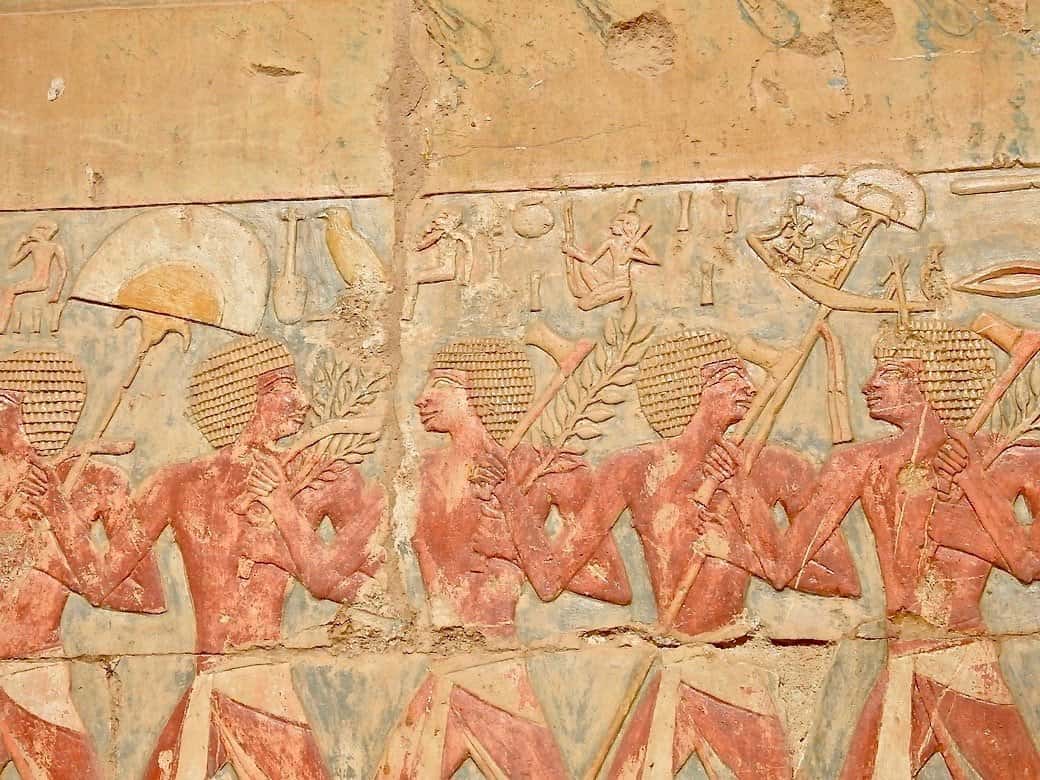
The Southern Colonnade / Things to See at the Temple of Hatshepsut
The transportation and erection of obelisks were not only remarkable engineering achievements but also potent symbols of the might and divine legitimacy of the pharaoh.
The obelisks of Queen Hatshepsut continue to be admired for their precision and artistic inscriptions, which provide insights into the religious and historical context of the time.
Today, visitors to Karnak Temple can still see the obelisks commissioned by Queen Hatshepsut, standing as enduring testaments to the architectural and religious achievements of ancient Egypt.
Second Level of the Temple
Next, take a wide ramp leading to the second level of the temple. Here, you will be greeted by several statues of Hatshepsut that are gradually getting restored.
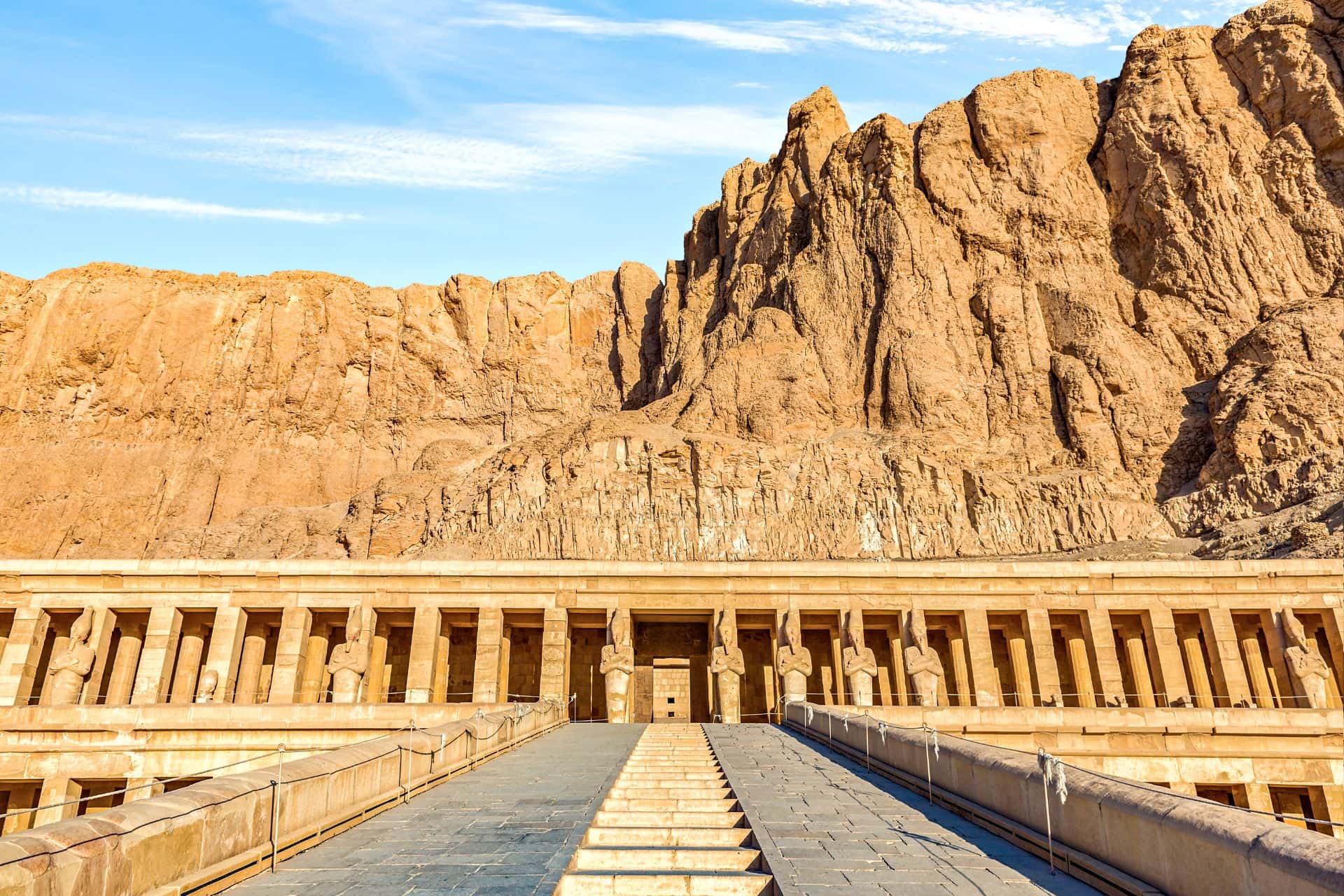
The ramp leading to the second level of the temple / Things to o See at the Temple of Hatshepsut
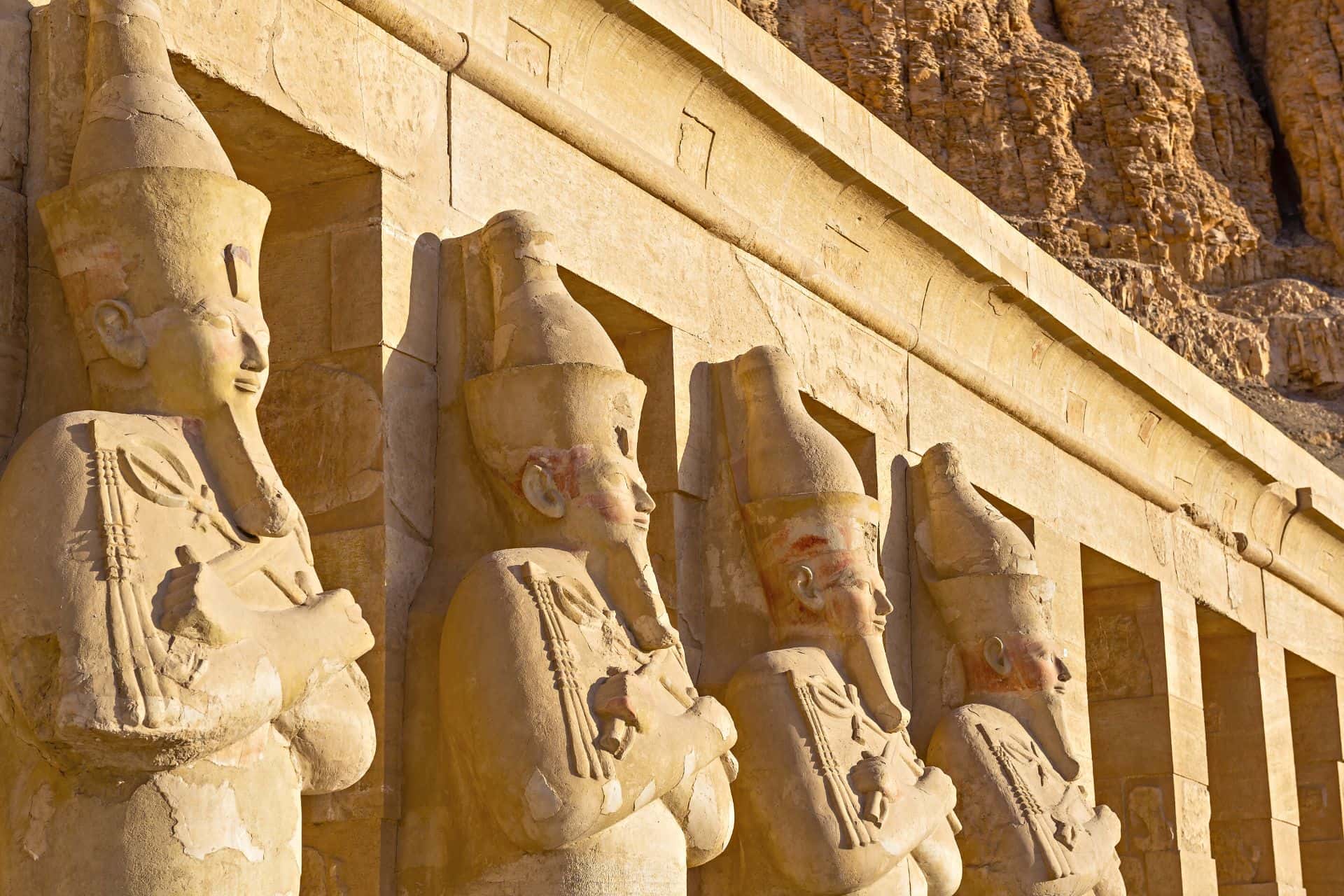
Statues of Hatshepsut / Things to See at the Temple of Hatshepsut
Chapel of Hathor
Next, turn left and make your way to check out the Chapel of Hathor.
The Chapel of Hathor at the Temple of Hatshepsut is a sacred sanctuary dedicated to the goddess Hathor, a prominent deity in ancient Egyptian religion.
Located within the larger temple complex, this intimate shrine features intricately carved reliefs, columns, and statues depicting the benevolent goddess, who was associated with music, dance, and motherhood.
It served as a place of worship and veneration, where priests and devotees conducted rituals and made offerings to seek the favor and blessings of Hathor. The chapel’s presence within the temple complex underscores Hathor’s significance in the religious beliefs and practices of ancient Egypt, as well as her role in the pharaoh’s divine lineage.
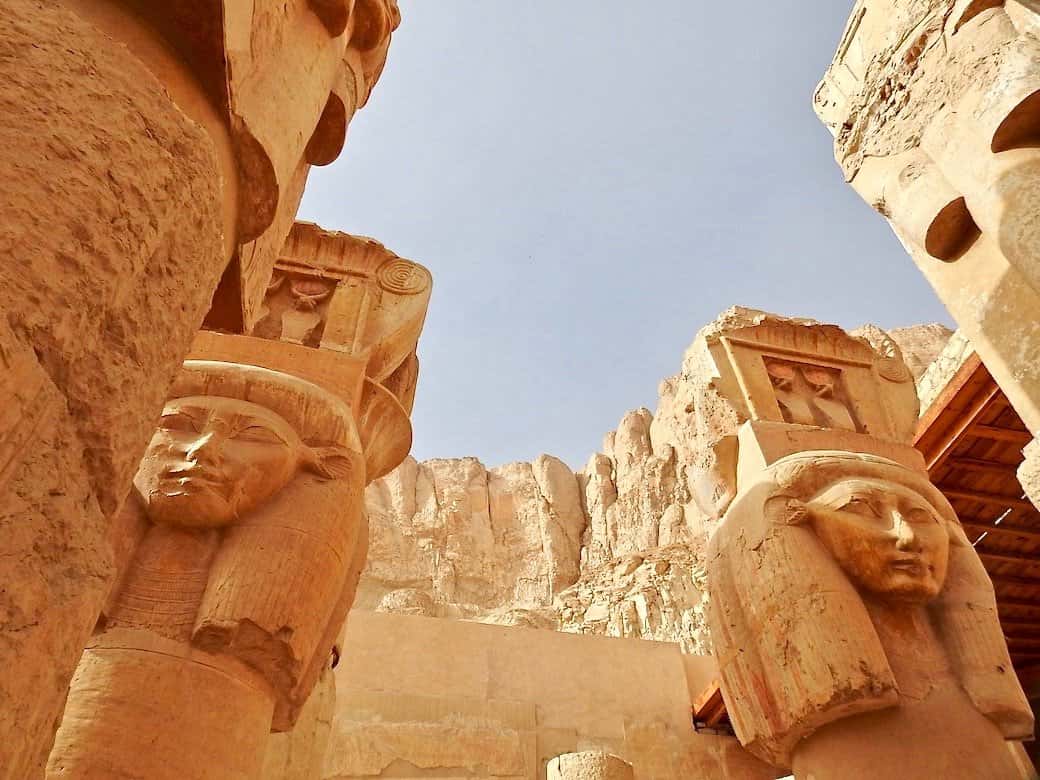
Chapel of Hathor / Things to See at the Temple of Hatshepsut
The Punt Colonnade
The Punt Colonnade, an integral part of the Temple of Hatshepsut, stands as a testament to the remarkable achievements of Queen Hatshepsut’s reign.
Located along the southern side of the temple complex, this architectural marvel consists of a row of columns adorned with intricate carvings that vividly depict scenes from Hatshepsut’s renowned expedition to the Land of Punt, a distant and exotic African kingdom.
The reliefs on these columns offer a captivating narrative, showcasing the journey by ship, encounters with the people of Punt, and the exotic treasures brought back to Egypt.
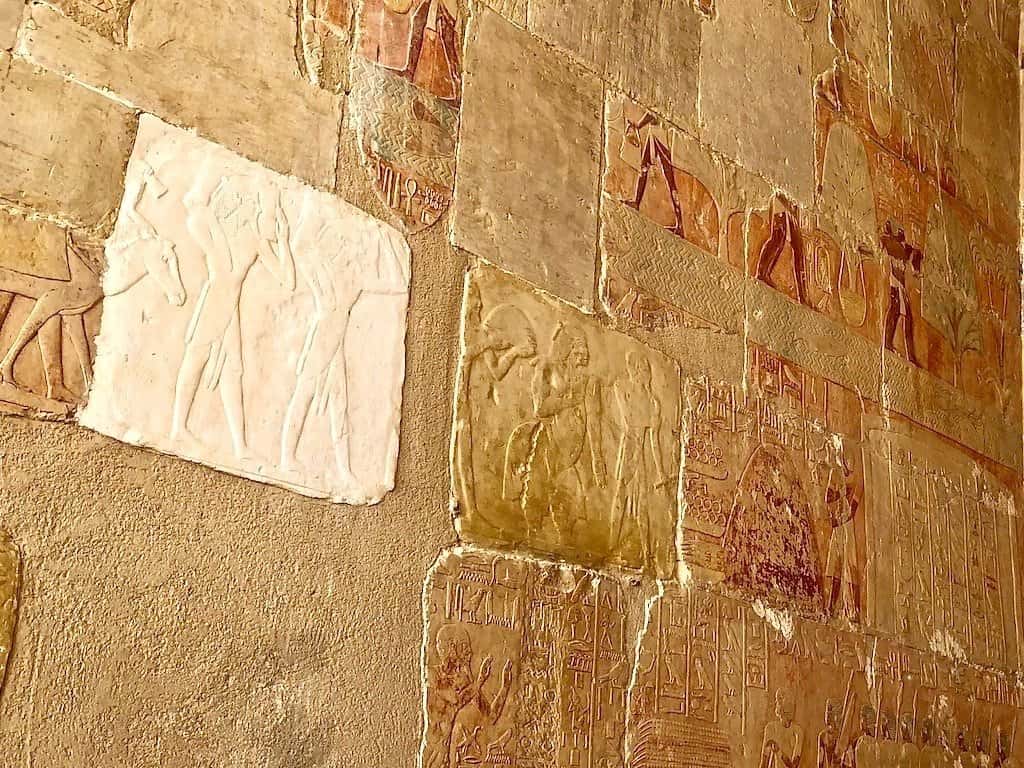
The Punt Colonnade / Things to See at the Temple of Hatshepsut
Furthermore, it shows a variety of trees and animals that were found in the Land of Punt.
Interestingly, some of the reliefs show the houses being constructed over the water with ladders leading up to the entrances.
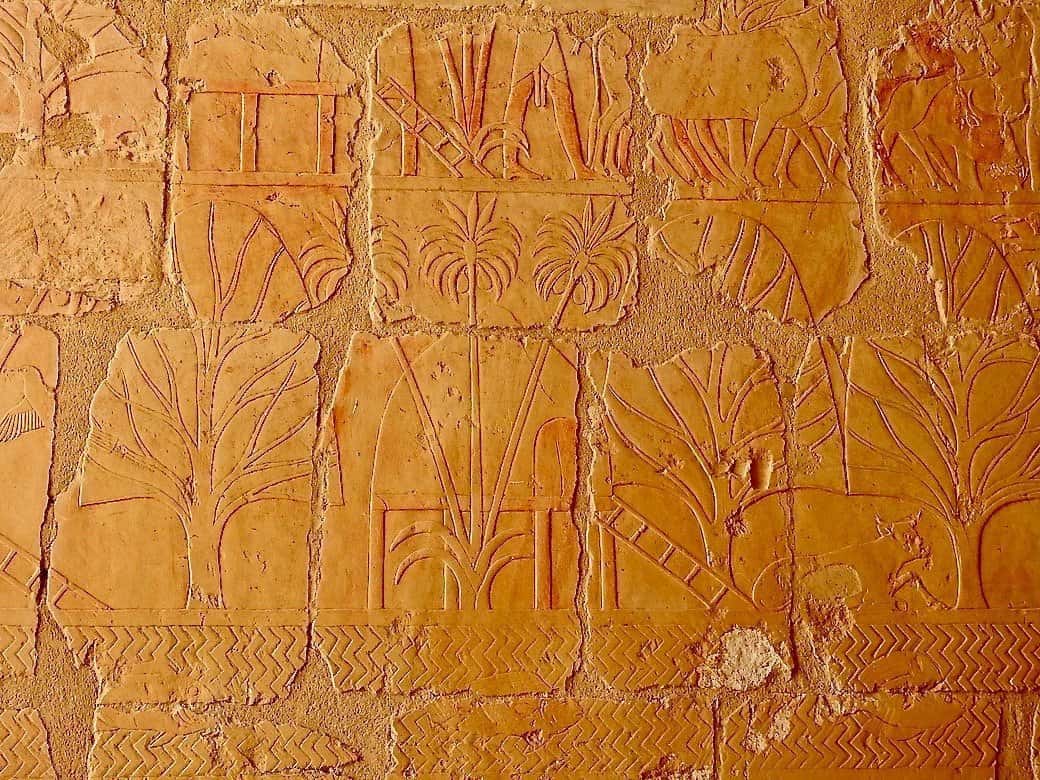
The Punt Colonnade / Things to See at the Temple of Hatshepsut
This colonnade not only commemorates the queen’s successful trading mission but also holds religious significance, reinforcing her divine status as pharaoh.
As you explore this historical treasure, you will be transported back in time to an era of prosperous trade, cultural exchange, and the enduring legacy of a remarkable ruler.
The Anubis Chapel
Next, make your way to the Anubis Chapel located on the opposite side of the second level.
The Anubis Chapel, also known as the Chapel of Anubis, is a significant component of the Temple of Hatshepsut. This sacred sanctuary is dedicated to Anubis, the venerable god of embalming and the afterlife, typically depicted with the distinctive head of a jackal.
As a pivotal figure in ancient Egyptian funerary practices, Anubis played a vital role in guiding souls to their eternal resting places and overseeing the meticulous mummification process.
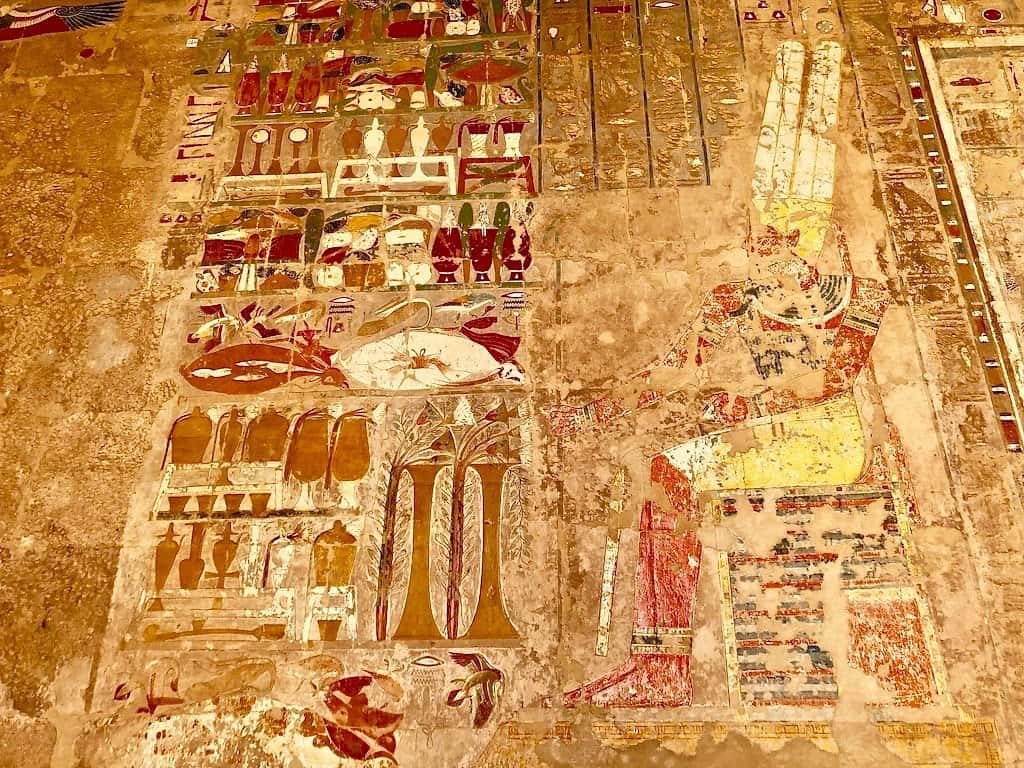
The Anubis Chapel / Things to See at the Temple of Hatshepsut
The chapel’s strategic placement within the temple complex underscores its paramount significance in the spiritual and mortuary rituals of ancient Egypt. Its architectural allure lies in its detailed columns, ornate walls adorned with hieroglyphics and reliefs, and the palpable sense of reverence that lingers in the air.
Here, within the hallowed walls of the Anubis Chapel, worshippers and priests alike would gather to perform sacred ceremonies, make offerings, and beseech the benevolent favor of Anubis for a smooth journey into the afterlife.
This sacred space further solidifies the profound connection between Queen Hatshepsut and the god Anubis, illuminating her steadfast commitment to ensuring a harmonious transition to the realm of the eternal.
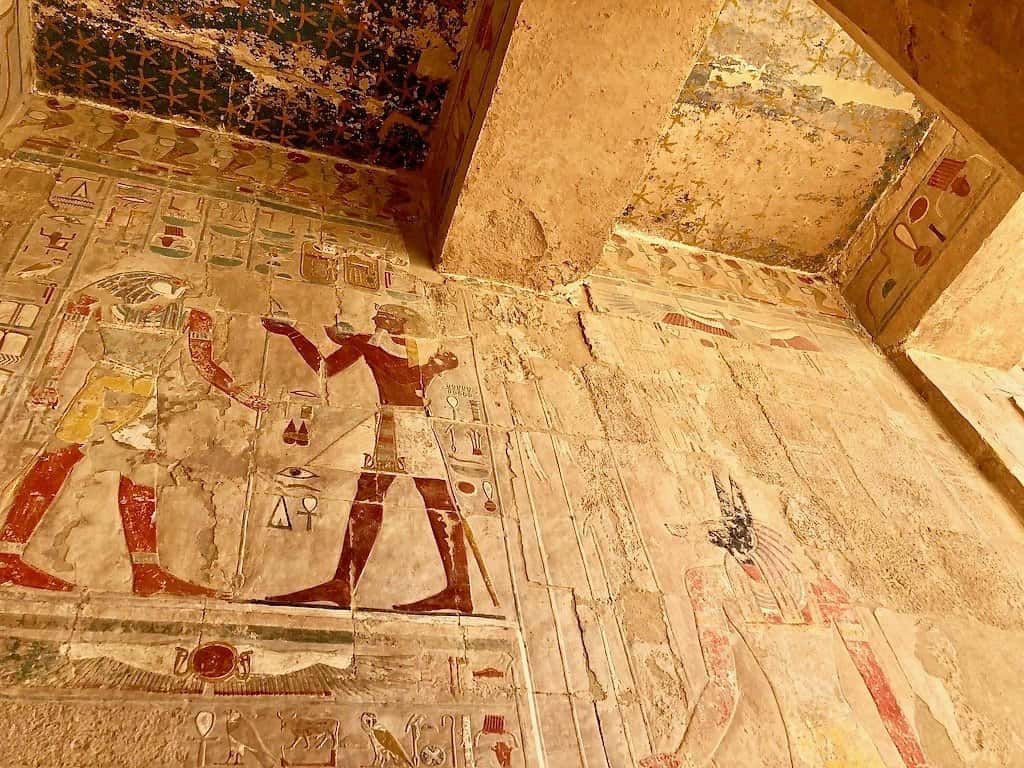
The Anubis Chapel / Things to See at the Temple of Hatshepsut
A visit to the Anubis Chapel is an immersive experience that offers a poignant glimpse into the intricate tapestry of ancient Egyptian funerary traditions and religious beliefs.
The intricate carvings and depictions adorning the chapel’s walls serve as an invaluable testament to the enduring legacy of Anubis, the guardian of souls, and the spiritual significance of the Temple of Hatshepsut.
The Sanctuary of Amun
Finally, make your way to the third level of the Temple of Hatshepsut and visit the Sanctuary of Amun.
The Sanctuary of Amun, a revered and integral component within the Temple of Hatshepsut, stands as a testament to the profound religious devotion of ancient Egypt. This sacred enclave is dedicated to Amun, one of the most significant deities in the Egyptian pantheon, often represented with a ram’s head, symbolizing fertility and creation.
Situated within the temple complex, the Sanctuary of Amun is a hallowed space characterized by its architectural elegance and spiritual significance.
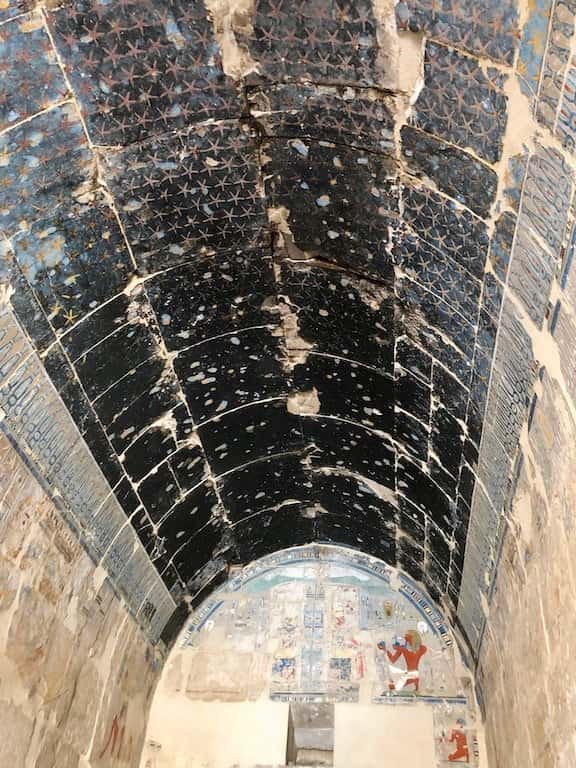
The Sanctuary of Amon / What to See at the Temple of Hatshepsut
Amun, known as the “King of the Gods,” held a position of unparalleled importance in Egyptian religion, often associated with the concept of hidden power and creator of all things. As such, this sanctuary was a place of profound reverence and worship.
Architecturally, the sanctuary features intricately designed columns and walls adorned with hieroglyphics and reliefs that depict scenes of offerings, ceremonies, and rituals dedicated to Amun. It was within these sacred walls that priests and devotees would gather to perform religious rites and present offerings to seek the god’s benevolent favor.
The Sanctuary of Amun was not merely a physical structure; it served as a bridge between the earthly realm and the divine. Here, the pharaoh and the priesthood would engage in rituals, appealing to Amun’s grace and guidance, ensuring the continued prosperity and stability of Egypt.
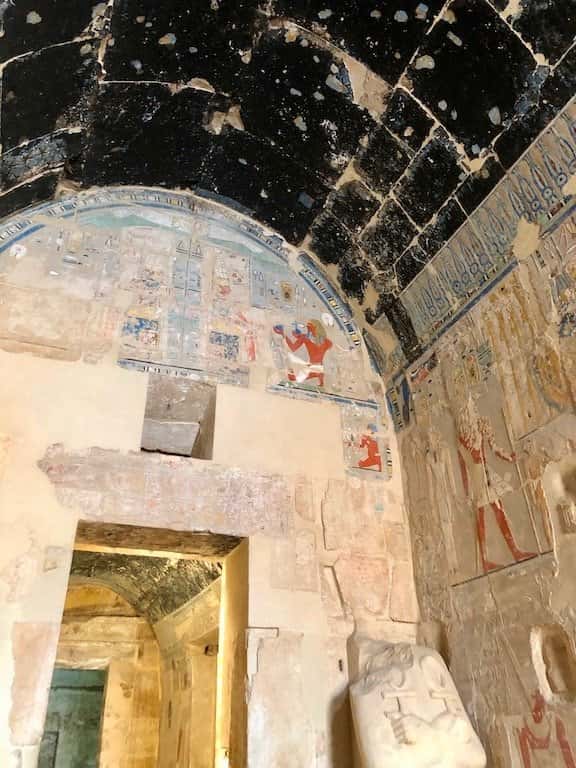
The Sanctuary of Amon / What to See at the Temple of Hatshepsut
This sanctuary’s presence within the Temple of Hatshepsut is a testament to the queen’s commitment to upholding the religious traditions and spirituality of her kingdom.
Intrepid Scout's Tips for Visiting the Temple of Hatshepsut
- The Temple of Hatshepsut is open daily from 6 am till 10 pm. However, the best time to visit the temple is before 8 am. You will practically have the entire place to yourself and be able to get some awesome photos without any people in them. The tourist buses start arriving at around 9-10 am and the place gets very crowded.
- Make sure to circle back to the temple in the evening to see it beautifully illuminated.
- The best way to get to the Temple of Hatshepsut is by having a driver and a tour guide. This option gives you total flexibility. You can decide how much time you need to see everything at the temple. Plus, having a knowledgeable guide by your side is absolutely priceless! If you are staying in one of the hotels in Luxor, your hotel will be more than happy to arrange for you a driver and a guide. Needless to say, this is an expensive option, but it is all worth it. Another option is to just book a taxi and head to the temple. You will always be able to hire a guide right at the entrance to the Temple of Hatshepsut.
You Might Also Like
10 Epic Things to See and Do at the Pyramids of Giza
12 Important TIPS for First VISIT to VALLEY of the KINGS in Luxor
12 Important TIPS for Hot AIR BALLOON RIDE in LUXOR, Egypt (Read Before You Book It)
Perfect 2-Day Itinerary in Luxor (7 Things You Can’t Miss)
14 EGYPT TIPS for FIRST TIMERS (How to Save Time, Money, and Be Safe)
How to Visit And What to See at ABU SIMBEL (9 Practical Things to Know)
How to Visit KARNAK TEMPLE in Luxor (9 Amazing Things You Can’t Miss)
19 Must-See Things at Egyptian Museum in Cairo (+Practical Tips)
Why You Should Visit Horus Temple of Edfu in Egypt
Did You Find This Useful?
Why Not Save What to See at the Temple of Hatshepsut to Your Pinterest Board!
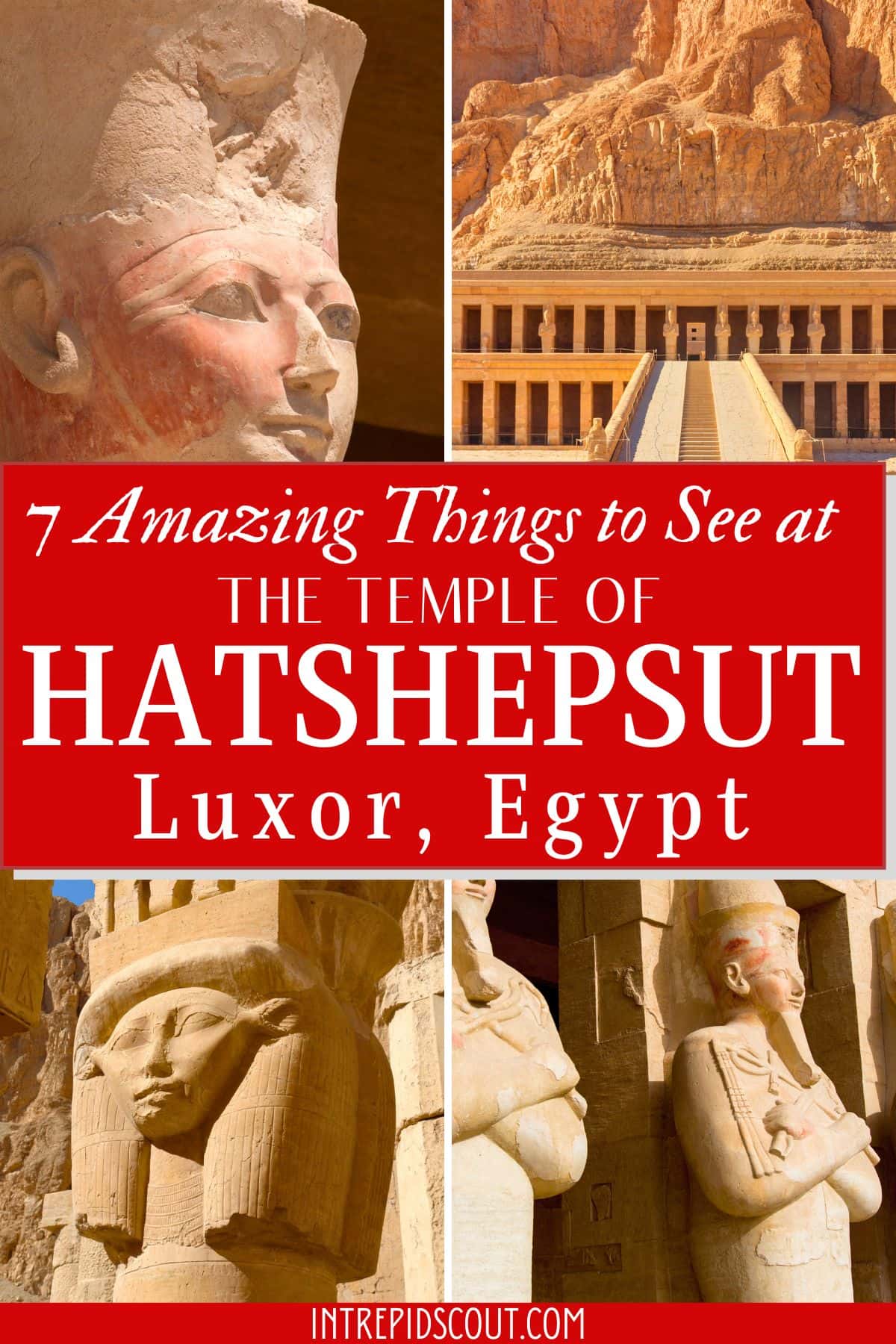
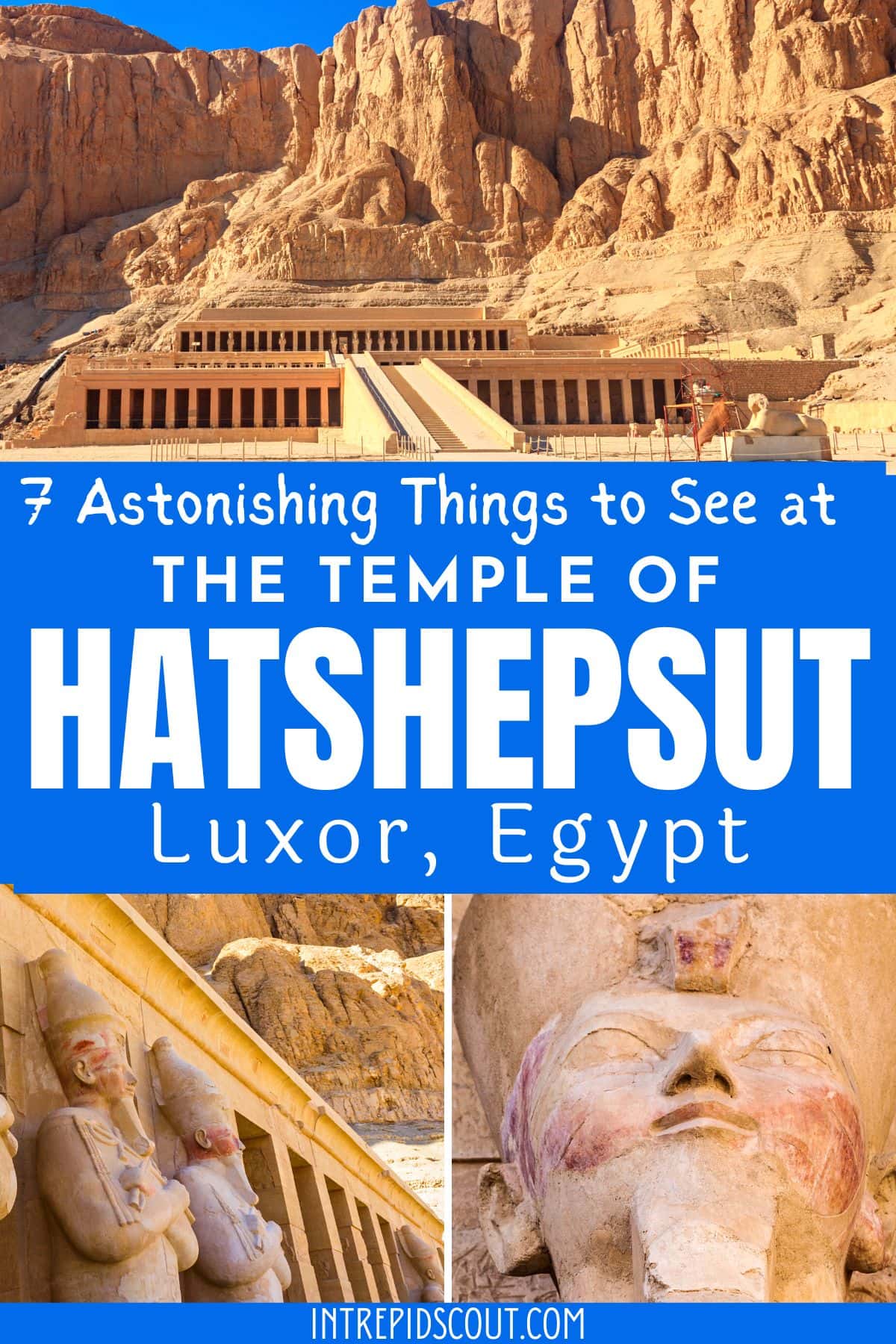
Now, It Is Your Turn, I Would Like to Hear Back from You!
Are you planning a trip to Luxor?
Please let me know! Drop me a quick comment right below!
Click on any of the images below to get inspired and to help you with the planning process for your trip to Egypt!
